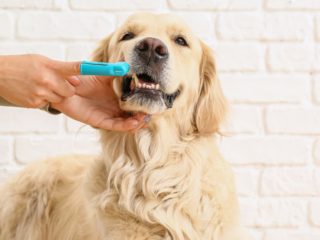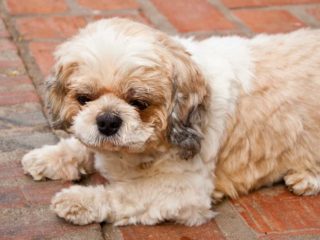If you have a Cocker Spaniel, you have likely noticed their unique coat which is often recognized for its beautiful soft fur but, have you ever noticed how thick their coats are?
Because of these thick coats along with other factors, new Cocker Spaniel owners are sometimes unsure about bathing their dogs themselves. If you need tips and tricks to help your dog’s bath process run smoothly at home, then keep reading!
Do Cocker Spaniels like baths?
A lot of dog owners’ first concerns when thinking of bathing their pup at home is whether or not they will like having a bath.
Each dog reacts differently to bath time; although, a significant number of Cocker Spaniel owners agree that their dogs love the water! For dogs who are timid or don’t like bath time training can be used to help them overcome their dislike.
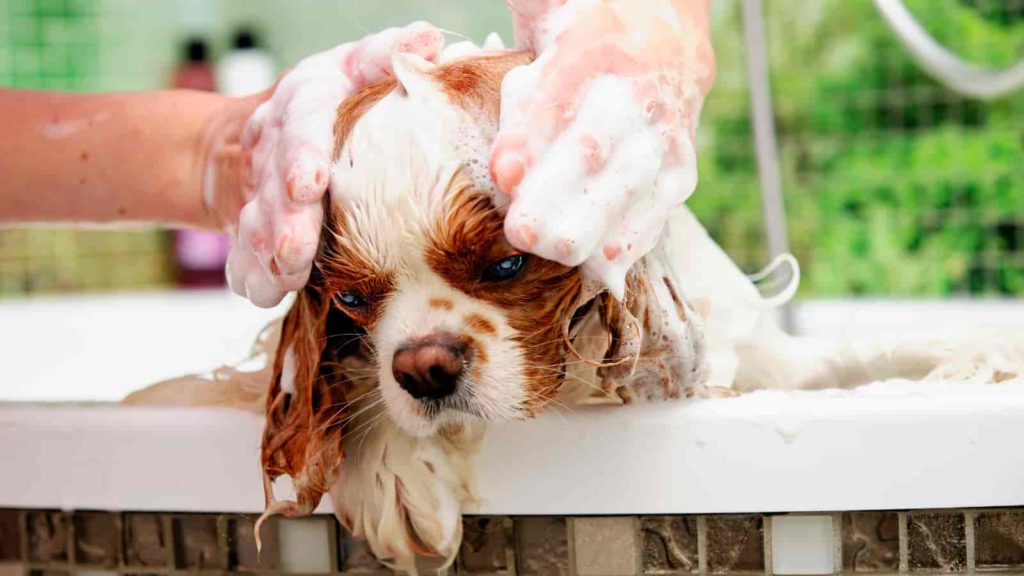
Cocker Spaniels are known for their double coats (2 layers of fur). The bottom layer is closest to their skin and is thick and dense, also called the “undercoat,” the top layer is stiff and coarse. Because of this thick coat, Cocker Spaniels can get hot quickly, this is one of many reasons why they love baths and being in water in general — it is an easy way to cool off!
Learn more about a Cocker Spaniel‘s double coat by reading this article:
Shaving Your Cocker Spaniel, Is it Ever Ok? (The Truth Revealed)
Do Cocker Spaniels need baths?
Due to their double coat, a Cocker Spaniel‘s fur is water-repellent. They do not need baths as often as other breeds because of their unique fur. If you over bathe your Cocker Spaniel more than necessary, it may lead to dry skin and hair loss.
Disclaimer: This post may contain affiliate links. We only recommend high-quality products that are used and recommended by real owners. If you use these links to buy something we earn a small commission.
Although Cocker Spaniels do not need baths as often as other dog breeds, it is important to bathe and groom your Cocker Spaniel during heavy shedding periods. Cocker Spaniels are known for their large amounts of fur!
One useful tool that I have found helpful is the Furminator, which is great for reducing the amount of loose hair on your dog. This tool is great because if used correctly 1–2 times weekly, it does not damage the coat or cut your dog’s skin.
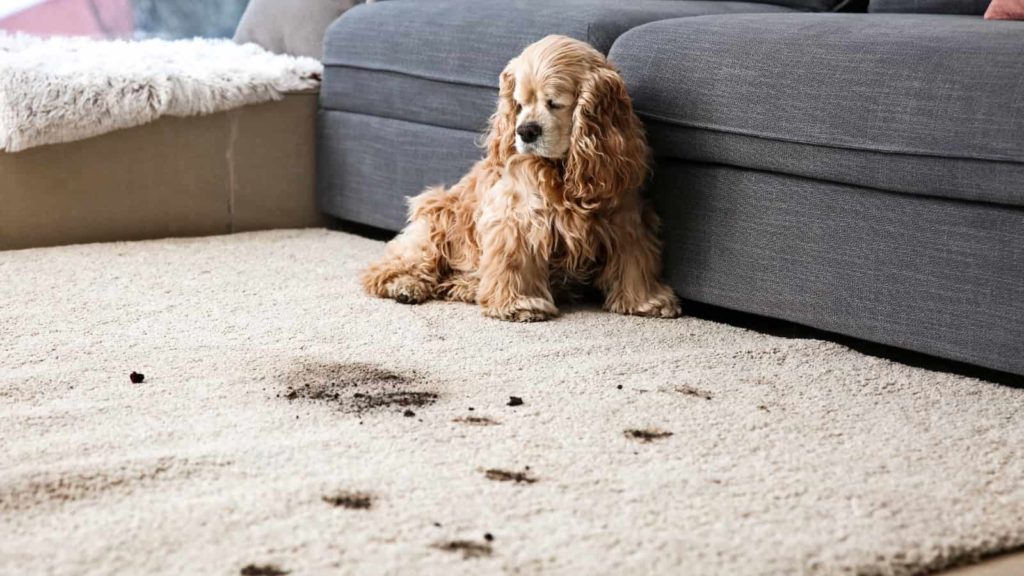
Do Cocker Spaniels smell?
Cocker Spaniels are generally a breed that doesn’t smell bad unless they have rolled in something or have been in a very dirty working environment such as a farm around pigs or livestock. Their coat is water and dirt repellent and will keep most smells away.
Why do Cocker Spaniels Smell? (Bad Breath, Farts, and More!)
The exception to this is during high shedding times.
Not only is it important to bathe and groom your Cocker Spaniel during heavy shedding periods to maintain their appearance and comfort, but it is also key in preventing any odor.
Tip: Bathing can help quite a bit when your dog is blowing their coat. Many owners say their dog looks completely different after a brush and a bath when blowing their coat.
Cocker Spaniels have a unique and natural smell to their fur that tends to become stronger when they are heavily shedding. This is why it is important to keep their coat maintained, especially when shedding is at its highest. If their coat is not properly maintained and they are left without a bath for too long, the smell becomes even more powerful.
How often can I bathe my Cocker Spaniel?
How often your dog gets dirty and where you live has a lot to do with how often you should be bathing your Cocker Spaniel. Depending on your location, your dog may be exposed to different environments that cause them to get dirty more quickly.
An active dog, and one that is outside often, may require bathing on a more regular basis (every 4–6 weeks), whereas a Cocker Spaniel that spends a lot of their time inside may only need a bath every 3–6 months.
There is no specific time range that a Cocker Spaniel should be bathed, each dog is different! If you notice your dog needing a bath before 4 weeks, go for it!
Some owners wonder if they can bathe their Cocker Spaniel too often.
You will know you are bathing your dog too often if your Cocker Spaniels skin starts to dry out and gets itchy. Generally bathing your dog regularly every week for a prolonged period of time is too often and will strip your dog’s natural oils from their skin.
It’s ok if your dog is in a season of getting dirty more often from playing outside and gets more regular bathes for a few months in a row. To keep your dogs skin from drying out you will want to use a very mild shampoo or none at all.
Using shampoo for every other bath is also a good idea to help keep your dogs skin from drying out.
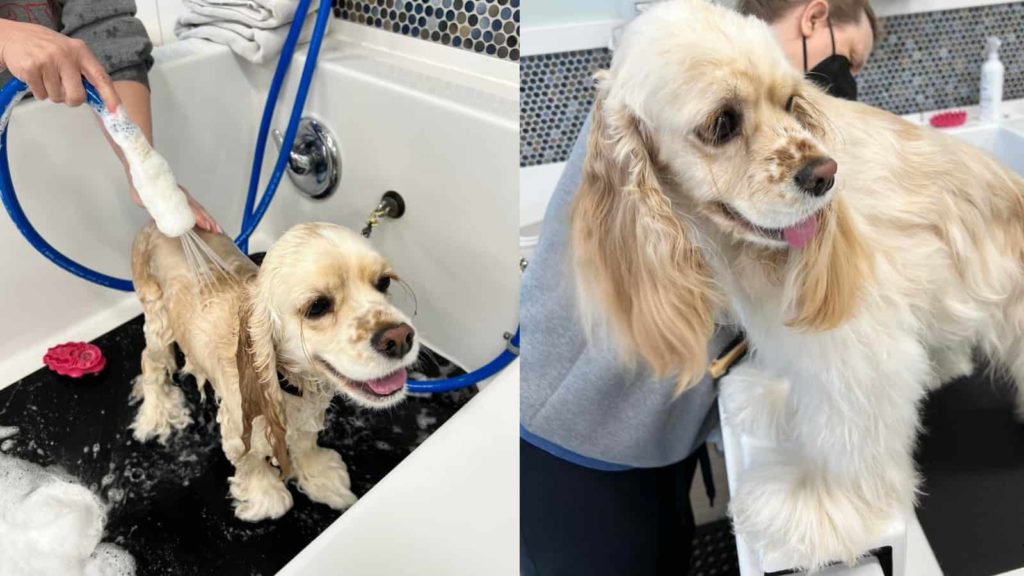
What shampoo is best for a Cocker Spaniel?
Choosing a good shampoo and conditioner for your dog is one of the most important decisions involving their bath. There are several things to keep in mind when looking for the best shampoo and conditioner for your dog:
- If your dog has any skin conditions
- If your dog has fleas or ticks or is known for having them previously
- If your dog has an odor
- If you are wanting your dog’s fur to shine
- If your dog struggles with tangled fur
- If your dog is young or old
- If your dog is allergic to any specific ingredients.
Taking these points into consideration can help narrow down your shampoo and conditioner search significantly.
Always remember not to use human shampoo or conditioner on your dog, certain fragrances and dyes can irritate, dry out, and damage your dog’s skin. Many Cocker Spaniel owners recommend using non-toxic and non-stripping shampoos so that the fur and skin do not dry out.
Cocker Spaniels are known for having allergies mostly due to genetics; however, other factors can influence allergies such as diet, grasses, pollen, mold, dust, medicines, and especially what you are using on their fur and skin during bath time!
Choosing specific bath products that you find don’t irritate your pup is key in preventing any serious allergies as well as ensuring that they are their happiest and healthiest selves!
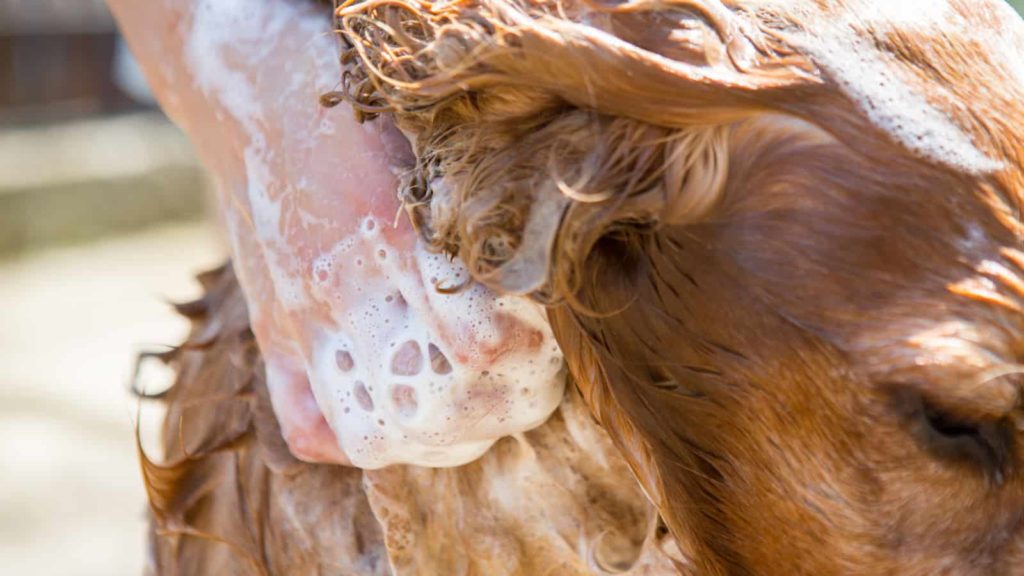
Most recommended by owners shampoos for Cocker Spaniels:
- Oatmeal Shampoo and Hypoallergenic Shampoo (Great for Cocker Spaniels with allergies and sensitive skin — soothes dryness, itchiness, and irritation)
- Puppy Shampoo (Great for Cocker Spaniel puppies)
- Thick Double Coat Shampoo (Great for shedding control)
- Probiotic Shampoo + Conditioner (Contains avocado oil and omega-3s)
- Burt’s Bees’ Oatmeal Shampoo and Conditioner (Burt’s Bees’ also has shed-control, itch-soothing, hot spot, waterless, and hypoallergenic shampoos), which can all be found HERE!
A lot of times dog owners will focus solely on shampoo and conditioner when preparing for their dog’s bath, forgetting about the other wonderful and unique bath and grooming products, tools, etc. that are available! Some other items that can be useful during your dog’s bath time include:
- Scent Spray
- Whitening Shampoo
- Detangling Spray
- Deodorizing Bath Wipes
- Bath Brush Sprayer (Great for outdoor baths and for getting shampoo out of the undercoat)
How to bathe my Cocker Spaniel at home (step-by-step)
Some Cocker Spaniel owners worry about the correct steps to take to bathe their Cocker Spaniel at home properly. Below is a step-by-step guide on bathing your Cocker Spaniel at home. By taking these steps you can ensure a positive bath experience for your dog!
Bath prep:
- Lie all of the necessary products and tools out before you begin. It is helpful to have the necessary items nearby so you don’t have to leave your dog in the shower or bath alone.
Staying by your pup’s side throughout the bathing process can eliminate any stress or anxiety they are feeling. Having the bath products nearby can also help you avoid forgetting any steps in your dog’s bath routine! - Make sure to start running the bath or shower water before your dog enters. Finding the right temperature of the water is important; having the water too hot could burn you or your dog’s skin and having the water too cold can cause discomfort for your pup. Starting the water before your dog enters the bathing area can also help eliminate the stress your pup may be feeling!
- If you have a bathtub, you may have to lift your dog into the tub. Start by placing one arm on their chest (under the two front legs) and scoop with your other arm to bring their back legs in, supporting their backside. This lifting method takes any strain off of your dog’s back and results in the most comfortable position for you as well!
- It is important that your dog does not fall while having their bath. If your tub or shower is slippery, you may want to consider laying a rubber mat on the floor to prevent your dog from falling. It may also be helpful to lay towels on the bathroom floor so your pup doesn’t fall after coming out of the tub or shower.
- If you have a dog that is anxious and stressed about bath time, two ways to calm them down include; using a low voice and soft tone. Speaking to your dog softly and sweetly can be soothing for your dog, resulting in their stress fading away.
Investing in an adhesive lick pad for your shower wall or tub can be helpful as well. By placing a distraction in front of your pup, they should be occupied enough for you to bathe them efficiently without causing them any discomfort or stress!
Tip: Seeing as Cocker Spaniels have so much hair, it is oftentimes a good idea to invest in a drain cover for your shower or bath to prevent any clogs caused by loose hair!
Step 1
Begin by running your fingers through your dog’s fur as you spray the water onto them. Don’t start at the head because this may cause your pup to feel anxious and begin shaking or trying to escape the shower or tub.
A significant number of Cocker Spaniel owners found that washing the head last resulted in an overall better bath experience. Washing their head last can help to avoid them from getting too cold in the bath which could cause them to shiver or shake.
Step 2
Use the shampoo and lather it in your hands before applying it to a section of your Cocker Spaniel’s fur. Begin washing in sections — because Cocker Spaniel’s fur dries so quickly, it is important to wash in one section at a time or in different zones of the body (belly, sides, back, etc.) so that the fur doesn’t dry up and cause shampoo to get stuck.
I like using a loofa to scrub my dog’s fur. It makes it easier to get a nice sud from the shampoo and quicker to get into the hard places like around the groin and under the arms.
It is recommended to rinse the fur from top to bottom (back to stomach), this causes the water to fall downward, washing out any shampoo that is left behind. It is very easy for shampoo to get stuck in a Cocker Spaniel’s undercoat; there is no such thing as “over rinsing,” when it comes to these dogs — Rinse, Rinse, Rinse!
Tip: Praise your dog often throughout their bath. Remind them that they are doing a good job. Bath time is supposed to be a positive experience, reminding your dog that it is doing “so good!” can also help alleviate any stress or discomfort they may be feeling.
Step 3
After shampooing and conditioning your dog’s entire body, it is now time to wash the head. When spraying water on your pup’s head, try pushing any water away from their eyes to avoid any discomfort or risk of getting shampoo or conditioner in their eyes that could lead to irritation.
It is important to avoid getting any water inside your dog’s ear(s). If any water enters their ear(s), normally there is nothing to worry about, just be sure to dry their ear(s) well once they are done with their bath; however, if the water sits in a dog’s ear too long, there is a risk for infection.
Thankfully there are products available that help with drying up any water stuck in your dog’s ear!
Step 4
Some Cocker Spaniel owners may be surprised to find that Cocker Spaniel paws hold a lot of water! Because of this, it is important to dry their feet last after all the water has fallen off of them.
Use a towel to dry the paw and between the toes so that no water is left behind that could cause dry skin or irritation, you may also choose to blow-dry your pup too!
Tip: It is likely that your dog will shake after its bath! If you have doors or a curtain on your shower or tub, it is a good idea to leave them closed for a moment to see if your pup is planning on shaking water everywhere!
Bathing a Cocker Spaniel Puppy for the first time.
Cocker Spaniel puppies can have their first bath at around 8 weeks old.
The most important thing to remember when bathing your puppy for the first time is to make sure it is a positive experience. Take your cues from your dog and if they seem hesitant or anxious then proceed cautiously or take a break.
Here are some tips for making your Cocker Spaniel’s first bath a success.
- Make your bath area fun and inviting.
- Introduce your dog to the bath area while it’s still dry. Play with them in the tub or sink are (without any water first) and offer them treats.
- Run the bathwater when your puppy is not in the tub yet. The sound and sight of the running water can be startling for some puppies.
- Practice washing their paws and only putting a few inches of water in the bathing area first. Give lots of praise and attention.
- When your puppy feels comfortable in the bathing area you can give them their first bath.
Make sure the water temperature is lukewarm. - Wash their head last as this will help to keep them from getting too cold.
- Use a washcloth to wash their head and around their eyes to avoid getting water and soap in their eyes.
- Keep your puppy in a warm room until completely dry. Making the bathing room warm before starting the bath can also help.
- Make sure to give them lots of praise and cuddles afterward!
Should I air-dry or blow-dry my Cocker Spaniel?
Although Cocker Spaniels dry super quickly, especially on their topcoat; sometimes there is moisture still present on their undercoat. Because of this, a lot of Cocker Spaniel owners blow-dry their dogs.
If you are planning on blow-drying your Cocker Spaniel, it is important to keep the nozzle of the dryer several inches away from their fur so that they don’t get burned. Keeping the airflow moving constantly can also avoid this issue.
Blowing the fur in one consistent direction (normally in the direction of hair growth) will cause the fur to lay flat. If you were to blow the hair in the opposite direction of the hair growth, the fur will likely curl up and become messy.
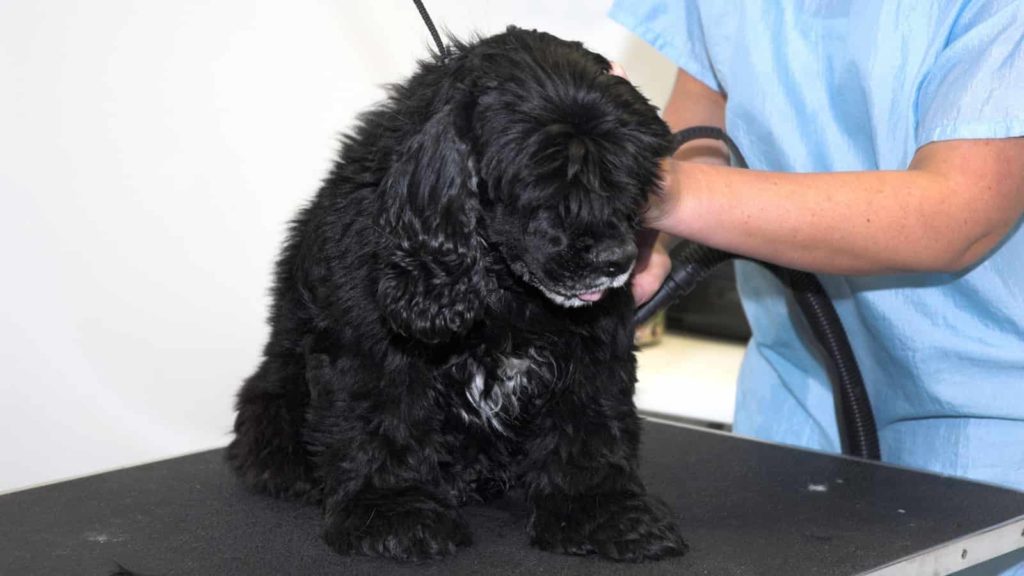
If you plan to blow-dry your pup rather than let them air dry, you will want to brush and dry the undercoat very well. If you don’t, there could be some moisture left behind, resulting in the fur becoming a curled mess that is very matted.
Cocker Spaniel owners tend to blow dry their pups often, not only because of the points above but also because a lot of Cocker Spaniels have sensitive skin.
By blow-drying your dog instead of letting them air dry, irritation to the skin can be avoided since there is no moisture left in the fur for a long time; instead, your dog will have completely dried fur and skin after their bath. Blow-drying also helps eliminate any odor that would arise due to moisture being left on the fur!
Tips for keeping your Cocker Spaniel clean between Baths
Once you have taken the time to groom and bathe your beautiful Cocker Spaniel or if you have taken your dog to the groomer and had them washed the last thing you want is for them to start smelling poorly again a few days later.
Here are some tips to help them stay clean in-between grooming sessions.
- Wash your dog’s bedding and toys.
- Use a paw washer and absorbent mat at the door your dog comes in and out of the house.
- Brush regularly (daily) to keep dirt and debree from building up in their fur.
- Make sure that your dog has proper dental care and routine.
- Keep their groin and anus areas trimmed and clean.
- Keep these dog wipes handy for quick spot cleans.
We hope this article has been helpful for you in giving your dog a good experience for bath time. You can check out our other Cocker spaniel grooming tips in these articles!
Cocker Spaniel Shedding Guide (Tips and Tricks From Owners)
Shaving Your Cocker Spaniel (Is it Ever Ok?)
All About Cocker Spaniel Paws (Size, Grooming, Problems)
Cocker Spaniel Teething and Teeth Care Guide
Cocker Spaniel Tail Complete Guide (Docking, Grooming, Communication)
While we strive to give the most accurate and helpful information about your pet’s health that we can, this article is meant to be informational only and not medical advice. Never disregard, avoid or delay in obtaining medical advice from your veterinarian or other qualified veterinary health care provider regardless of what you have read on this site or elsewhere.


